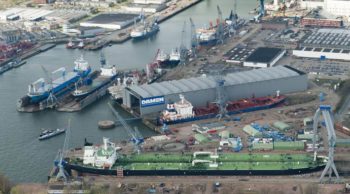
Marking a major step forward in the application of 3D printing in the maritime sector, Netherlands-based Damen Shipyards Group has entered a cooperative consortium with the goal of developing the world’s first class-approved 3D printed ship propeller.
The consortium was established by Damen with Rotterdam-based RAMLAB, Promarin, Autodesk, and class society Bureau Veritas.
Damen says the idea for 3D printed propeller, to be called the WAAMpeller, is the result of one of its in-house student research programs.
“Three students from Delft Technical University were investigating the potential of 3D printing for us. They brought us into contact with the other members of the consortium,” explains Kees Custers, Project Engineer in Damen’s Research & Development department. “What is quite unique about this group of five companies is that, while we have joint interests, we also have individual aims. This leads to a very productive and cooperative atmosphere in what is a very exciting project.”
The propeller will be based on a Promarin design that is typically found on a Damen Stan Tug 1606. This 1,300mm diameter propeller weighs approximately 180kg. Using Autodesk software in the construction process, Port of Rotterdam’s RAMLAB will fabricate the WAAMpeller from a bronze alloy using the Wire Arc Additive Manufacturing (WAAM) process.
Bureau Veritas will be involved in the certification of the completed product; in what will be the first time that a metal 3D printed maritime component will be approved by Class.
Once the propeller has been printed, Damen will continue with full-scale trials.
“We will be performing a comprehensive programme that will include bollard pull and crash test scenarios. Our ambition is to demonstrate that the research phase for 3D printing in the maritime sector is over, and that it can now be effectively applied in operations.”
The first propeller is expected to be printed by summer 2017, with subsequent testing occurring in the Fall.
“Our aim is to build more effective, more cost-efficient and more environmentally friendly vessels,” said Damen’s Principle Research Engineer Don Hoogendoorn.
“The WAAMpeller project contributes to this goal because it not only marks an important advance in 3D printing, but it also has the potential to yield significant results in optimising future vessel designs. 3D printing technology brings with it an excellent opportunity to improve ship structures in terms of both performance and fuel consumption.”
Copyright Ships & Ports Ltd. Permission to use quotations from this article is granted subject to appropriate credit given to www.shipsandports.com.ng as the source.
